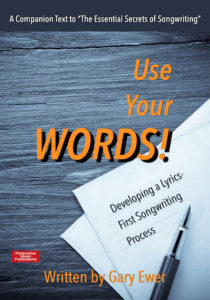A good lyric tells a story, whether that’s an actual “first this happened, then that happened” kind of lyric (like the stereotypical “A Boy Named Sue” – Johnny Cash), or whether the story happens indirectly, and we piece the details together, like Pink’s “Funhouse” (Pink, Tony Kanal, Jimmy Harry).
A lyric where the story is inferred in an indirect sort of way has its own challenges. In a way, you want a fuller story to be obvious even if you’re simply pulling together a series of descriptions, situations and circumstances.
 Do you wish lyrics played a more important role in your songwriting process. The ebook “Use Your Words! Developing a Lyrics-First Songwriting Process” shows you how to make lyrics the first and most important part of your songwriting method. It’s FREE right now, with your purchase of “The Essential Secrets of Songwriting 10-eBook Bundle”
Do you wish lyrics played a more important role in your songwriting process. The ebook “Use Your Words! Developing a Lyrics-First Songwriting Process” shows you how to make lyrics the first and most important part of your songwriting method. It’s FREE right now, with your purchase of “The Essential Secrets of Songwriting 10-eBook Bundle”
But if you find that your lyric sounds disorganized or somehow missing the mark, this is often the reason: even songs that aren’t specifically story songs often need to have a story implied in order to work well.
To that end, the best way to ensure that your song lyric pulls the listener along in a sensible, organized way is to start the lyric-writing process by writing a story.
There are many ways this process can take shape, but here’s one way that should always give you something strong to use as the basis for your lyric:
- Brainstorm titles or song ideas. A catchy title, even if you don’t know what it’s going to lead to yet, can often provide great material for a fuller story. So make a good list of titles that stimulate the imagination.
- Create a list of words and phrases that pertain to the title. Let’s say you’ve come up with “You Don’t Know Me” as a potential song title. Start thinking about what might lead someone to say that sentence. “You thought I’d always be there for you“; “You thought I’d let you down“; “You think that I’d give up on you“… that sort of thing. Eventually, one of these ideas will sound like the foundation for a story.
- Settle on a possible story based on the phrases you came up with in Step 2 above.
- Write a short story based on your idea. Don’t think at all about fashioning it into a lyric — that’s not the purpose here. Keep it short – 1-2 pages. Make it a true story in the sense that something happens with the potential for emotional connection by the audience.
- Write a new list of words and phrases that pertain to your story. Try to use words that you perhaps didn’t even use in your story. This step gives you the vocabulary you’ll use to rewrite your story in lyric form.
- Once you’ve got a good, long list, circle the words that are highly emotive, the ones you’d likely use in a song’s chorus. The other words will be ones you’d likely use in a verse.
- Between your story and your list of words and phrases, start working out your lyric.
Once you’ve arrived at Step 7, you’ll find that you’ve got a strong story in your mind, and the lyric you write that comes out of the previous 6 steps will benefit from the structure and organization that comes along with those steps.
So even if your song doesn’t take on the shape of a typical so-called story song, the fact that you’ve got a story in your mind keeps you from getting lost, and ensures that you’ve got situations and emotions happening in the right order.
A song that has the title “You Don’t Know Me” might only be a series of statements and opinions, but the fact that you happen to have written a story as a first step helps you create a powerful emotional arc that keeps your audience engaged and interested.
 Written by Gary Ewer. Follow Gary on Twitter.
Written by Gary Ewer. Follow Gary on Twitter.
 “The Essential Secrets of Songwriting” 10- eBook bundle comes with a free copy of “Use Your Words! Developing a Lyrics-First Songwriting Process”.
“The Essential Secrets of Songwriting” 10- eBook bundle comes with a free copy of “Use Your Words! Developing a Lyrics-First Songwriting Process”.











Great breakdown, Gary!
I follow the same steps in slightly different order, the only significant difference is that I keep the story to a paragraph or two.
Thanks Trevor. I think whatever gets a story sorted in your mind, whether 2 paragraphs or 2 pages, will be great. Cheers! -G